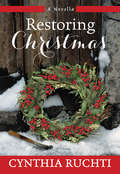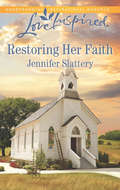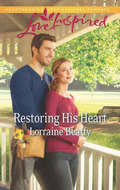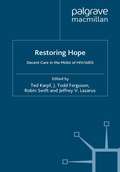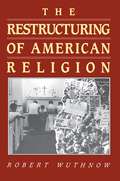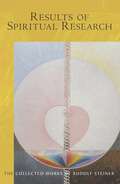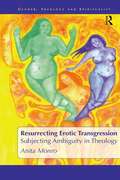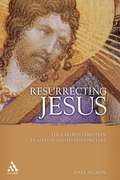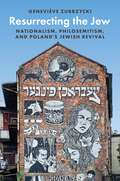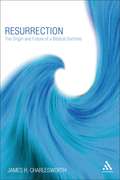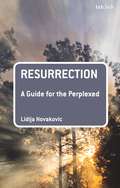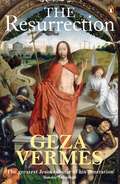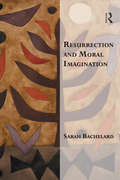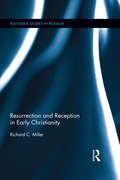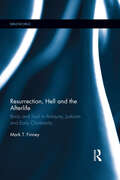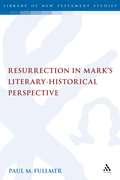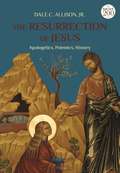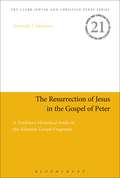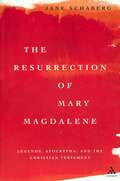- Table View
- List View
Restoring Christmas: A Novel
by Cynthia RuchtiAlexis Blake has one chance to land her own show on the Home Project Network and nothing-not an uncooperative client, a job site without indoor plumbing, or a challenging videographer-is going to stand in her way. Elsie, at seventy-plus, is far from the ideal client, but she knows exactly what she wants her fieldstone house to look like, and no designer can tell her otherwise. Gabe Langley, the man with the camera, is caught in the middle and it is his wisdom and warmth that just may be the bridge that will bring these two women together. Can they restore more than just a house and bring about special, almost lost forever Christmas memories?
Restoring Her Faith (Mills And Boon Love Inspired Ser.)
by Jennifer SlatteryShe left belief behind…Yet this family could change her mind.
Restoring His Heart (Mills & Boon Love Inspired): Rekindled Romance Restoring His Heart
by Lorraine BeattyA Love To Build On After he crashes his sports car into a gazebo, Adam Holbrook is sentenced to spend thirty days rebuilding it. Definitely not Adam's usual glamorous lifestyle. But when Laura Durrant, the contractor scheduled to help him, shows up, everything changes.
Restoring Hope: Decent Care in the Midst of HIV/AIDS
by T. Karpf T. Ferguson R. Swift J. LazarusThis volume is a call to re-examine assumptions about what care is and how it be practised. Rather than another demand for radical reform, it makes the case for thinking clearly and critically. It urges people living with HIV to become full partners in designing and implementing their own care and for caregivers to accept them in this role.
The Restructuring of American Religion: Society and Faith since World War II (Studies in Church and State #2)
by Robert WuthnowThe description for this book, The Restructuring of American Religion: Society and Faith since World War II, will be forthcoming.
RESULTS OF SPIRITUAL RESEARCH
by Rudolf SteinerIn a previously-unavailable series of talks to the general public, Rudolf Steiner builds systematically, lecture by lecture, on the fundamentals of spiritual science – from the nature of spiritual knowledge and its relationship to conventional science, the path of personal development and the task of metaphysical research, to specific questions on the mystery of death, the meaning of fairy-tales, the significance of morality and the roles of individual figures in human evolution, such as Leonardo da Vinci, Raphael and Jacob Boehme. At the time of these presentations, Steiner had already worked in Berlin for many years, and thus, ‘…could reckon with a regularly returning audience to whom what mattered was to enter ever more deeply into the areas of knowledge that were newly opening up to them’ (Marie Steiner). As a consequence – and through ‘a series of inter-connecting lectures whose themes are entwined with one another’ – he was able to communicate a coherent and challenging spiritual perception of reality, based on his personal research. Presented here with notes, an index and an introduction by Simon Blaxland-de Lange, the 14 lectures include: ‘How is Spiritual Science Refuted?’; ‘On What Foundation is Spiritual Science Based’; ‘The Tasks of Spiritual Research for both Present and Future’; ‘Errors of Spiritual Research’; ‘Results of Spiritual Research for Vital Questions and the Riddle of Death’; The World-Conception of a Cultural Researcher of the Present, Herman Grimm’ and ‘The Legacy of the Nineteenth Century’.
Resurrecting Erotic Transgression: Subjecting Ambiguity in Theology (Gender, Theology and Spirituality)
by Anita Monro'Resurrecting Erotic Transgression' presents a feminist theological methodology based on the work of Julia Kristeva. This methodology provides the means for 'subjecting ambiguity', bringing to theology a recognition of the multiplicity of language and identity. A method of 'poetic reading' is proposed with a three stage process: articulation of the dualities present in and around a focal discourse; subversion of these dualities through a range of strategies; and the re-presentation of the discourse emphasising its ambiguous nature. The hermeneutical method of 'poetic reading' is explored in relation to three biblical texts and an image of the 'otherness' of God as whore.
Resurrecting Erotic Transgression: Subjecting Ambiguity in Theology (Gender, Theology and Spirituality)
by Anita Monro'Resurrecting Erotic Transgression' presents a feminist theological methodology based on the work of Julia Kristeva. This methodology provides the means for 'subjecting ambiguity', bringing to theology a recognition of the multiplicity of language and identity. A method of 'poetic reading' is proposed with a three stage process: articulation of the dualities present in and around a focal discourse; subversion of these dualities through a range of strategies; and the re-presentation of the discourse emphasising its ambiguous nature. The hermeneutical method of 'poetic reading' is explored in relation to three biblical texts and an image of the 'otherness' of God as whore.
Resurrecting Jesus: The Earliest Christian Tradition and Its Interpreters
by Dale C. Allison Jr.Jesus remains a popular figure in contemporary cultureand Allison remains one of our best interpreters. He speaks around the country in avariety of venues on matters related to the study of the Historical Jesus. In his new book,he focuses on the historical Jesus and eschatology, concluding that the Jesus was not aHellenistic wonder worker or teacher of pious morality but an apocalyptic prophet. In anopening chapter that is worth the price of admission, Allison astutely and engaginglycaptures the history of the search for the historical Jesus. He observes that manycontemporary readings of Jesus shift the focus away from traditional theological,Christological, and eschatological concerns. In provocative fashion, He takes on not onlythe Jesus Seminar but also other Jesus interpreters such as N.T. Wright and Marcus Borg.
Resurrecting the Jew: Nationalism, Philosemitism, and Poland’s Jewish Revival (Princeton Studies in Cultural Sociology #18)
by Geneviève ZubrzyckiAn in-depth look at why non-Jewish Poles are trying to bring Jewish culture back to life in Poland todaySince the early 2000s, Poland has experienced a remarkable Jewish revival, largely driven by non-Jewish Poles with a passionate new interest in all things Jewish. Klezmer music, Jewish-style restaurants, kosher vodka, and festivals of Jewish culture have become popular, while new museums, memorials, Jewish studies programs, and Holocaust research centers reflect soul-searching about Polish-Jewish relations before, during, and after the Holocaust. In Resurrecting the Jew, Geneviève Zubrzycki examines this revival and asks what it means to try to bring Jewish culture back to life in a country where 3 million Jews were murdered and where only about 10,000 Jews now live.Drawing on a decade of participant-observation in Jewish and Jewish-related organizations in Poland, a Birthright trip to Israel with young Polish Jews, and more than a hundred interviews with Jewish and non-Jewish Poles engaged in the Jewish revival, Resurrecting the Jew presents an in-depth look at Jewish life in Poland today. The book shows how the revival has been spurred by progressive Poles who want to break the association between Polishness and Catholicism, promote the idea of a multicultural Poland, and resist the Far Right government. The book also raises urgent questions, relevant far beyond Poland, about the limits of performative solidarity and empathetic forms of cultural appropriation.
Resurrecting the Jew: Nationalism, Philosemitism, and Poland’s Jewish Revival (Princeton Studies in Cultural Sociology #18)
by Geneviève ZubrzyckiAn in-depth look at why non-Jewish Poles are trying to bring Jewish culture back to life in Poland todaySince the early 2000s, Poland has experienced a remarkable Jewish revival, largely driven by non-Jewish Poles with a passionate new interest in all things Jewish. Klezmer music, Jewish-style restaurants, kosher vodka, and festivals of Jewish culture have become popular, while new museums, memorials, Jewish studies programs, and Holocaust research centers reflect soul-searching about Polish-Jewish relations before, during, and after the Holocaust. In Resurrecting the Jew, Geneviève Zubrzycki examines this revival and asks what it means to try to bring Jewish culture back to life in a country where 3 million Jews were murdered and where only about 10,000 Jews now live.Drawing on a decade of participant-observation in Jewish and Jewish-related organizations in Poland, a Birthright trip to Israel with young Polish Jews, and more than a hundred interviews with Jewish and non-Jewish Poles engaged in the Jewish revival, Resurrecting the Jew presents an in-depth look at Jewish life in Poland today. The book shows how the revival has been spurred by progressive Poles who want to break the association between Polishness and Catholicism, promote the idea of a multicultural Poland, and resist the Far Right government. The book also raises urgent questions, relevant far beyond Poland, about the limits of performative solidarity and empathetic forms of cultural appropriation.
Resurrection: The Origin and Future of a Biblical Doctrine
by James H. CharlesworthResurrection is the central feature of the New Testament gospels and lies at the center of many of Paul's letters as well. In addition, the doctrine of the resurrection lies at the core of the Christian church's faith. The essays in this stunning collection explore the idea of resurrection as the idea appears not only in the New Testament texts but also in the Dead Sea Scrolls, the pseudepigraphal Testaments of the Twelve Patriarchs, and in contemporary theology. Charlesworth asks where the concept of resurrection appears and the ways we know it, and he also examines the concept of resurrection in the Dead Sea Scrolls and the New Testament. Casey Elledge explores the earliest evidence we have for a notion of a resurrection of the dead and investigates the hope for Israel in Judaism and Christianity found in the Testaments. Crenshaw looks at the Hebrew Bible's ideas of resurrection, and Hendrikus Boers examines the meaning of Christ's resurrections in Paul's writings. W. Waite Willis explores a theology of resurrection.
Resurrection: A Guide for the Perplexed (Guides for the Perplexed)
by Lidija NovakovicThis volume examines what the followers of Jesus meant when they declared that he was raised from the dead. This claim, which lies at the core of Christian faith, is one of the most controversial topics in Christianity. Jesus' resurrection has no analogy in human history. Although many 1st-century Jews expected the resurrection of the dead at the end of time, the Christian claim that this had already happened to one individual within the realm of history was unprecedented. Moreover, an affirmation of Jesus' bodily resurrection contradicts the known laws of nature. Additional difficulty comes from the nature of the available evidence. The New Testament sources not only mirror the worldview of ancient authors but also differ with regard to who saw him alive, what was the nature of his risen body, and whether the empty tomb was a widespread knowledge or an assumption based on prior beliefs. Novakovic presents all these issues in a clear and methodical way. She examines the literary sources and addresses various questions related to historical investigations of Jesus' resurrection.
Resurrection: The Role Of The Old Testament In The Early Christian Interpretations Of Jesus' Resurrection (Guides for the Perplexed #12)
by Lidija NovakovicThis volume examines what the followers of Jesus meant when they declared that he was raised from the dead. This claim, which lies at the core of Christian faith, is one of the most controversial topics in Christianity. Jesus' resurrection has no analogy in human history. Although many 1st-century Jews expected the resurrection of the dead at the end of time, the Christian claim that this had already happened to one individual within the realm of history was unprecedented. Moreover, an affirmation of Jesus' bodily resurrection contradicts the known laws of nature. Additional difficulty comes from the nature of the available evidence. The New Testament sources not only mirror the worldview of ancient authors but also differ with regard to who saw him alive, what was the nature of his risen body, and whether the empty tomb was a widespread knowledge or an assumption based on prior beliefs. Novakovic presents all these issues in a clear and methodical way. She examines the literary sources and addresses various questions related to historical investigations of Jesus' resurrection.
The Resurrection
by Geza VermesThe story of Christ’s crucifixion and subsequent resurrection is the rock of faith on which Christianity is founded. But on what evidence is the most miraculous phenomenon in religious history based? World-famous Biblical scholar Geza Vermes has studied all the evidence that still remains, over two thousand years after Jesus Christ was reported to have risen from the dead. Examining the Jewish Bible, the New Testament and other accounts left to us, as well as contemporary attitudes to the afterlife, he takes us through each episode with a historian’s focus: the crucifixion, the treatment of the body, the statements of the women who found the empty tomb, and the visions of Christ by his disciples. Unravelling the true meaning conveyed in the Gospels, the Acts and St Paul, Vermes shines new light on the developing faith in the risen Christ among the first followers of Jesus.
Resurrection and Moral Imagination (Transcending Boundaries in Philosophy and Theology)
by Sarah BachelardMoral life gathers its shape, force and meaning in relation to an underlying sense of reality, imaginatively conceived. Significant contemporary writing in philosophy appeals to the concept of ’transcendence’ to explore what is deepest in our moral experience, but leaves this notion theologically unspecified. This book reflects on the appeal to transcendence in ethics with reference to the Resurrection of Jesus. Bachelard argues that the Resurrection reveals that the ultimate reality in which human life is held is gracious, forgiving and reconciling, a Goodness that is ’for us’. Faith in this testimony transforms the possibilities of moral life, both conceptually and in practice. It invites our participation in a goodness experienced non-dualistically as grace, and so profoundly affects the formation of the moral self, the practice of moral judgement and the shape of moral concepts. From this perspective, contemporary philosophical discussion about 'transcendence' in moral thought is cast in a new light, and debates about the continuity between theological and secular ethics gain a thoroughly new dimension. Bachelard demonstrates that placing the Resurrection at the heart of our ethical reflection resonates with the deepest currents of our lived moral experience and transfigures our approach to moral life and thought.
Resurrection and Moral Imagination (Transcending Boundaries in Philosophy and Theology)
by Sarah BachelardMoral life gathers its shape, force and meaning in relation to an underlying sense of reality, imaginatively conceived. Significant contemporary writing in philosophy appeals to the concept of ’transcendence’ to explore what is deepest in our moral experience, but leaves this notion theologically unspecified. This book reflects on the appeal to transcendence in ethics with reference to the Resurrection of Jesus. Bachelard argues that the Resurrection reveals that the ultimate reality in which human life is held is gracious, forgiving and reconciling, a Goodness that is ’for us’. Faith in this testimony transforms the possibilities of moral life, both conceptually and in practice. It invites our participation in a goodness experienced non-dualistically as grace, and so profoundly affects the formation of the moral self, the practice of moral judgement and the shape of moral concepts. From this perspective, contemporary philosophical discussion about 'transcendence' in moral thought is cast in a new light, and debates about the continuity between theological and secular ethics gain a thoroughly new dimension. Bachelard demonstrates that placing the Resurrection at the heart of our ethical reflection resonates with the deepest currents of our lived moral experience and transfigures our approach to moral life and thought.
Resurrection and Reception in Early Christianity (Routledge Studies in Religion)
by Richard C. MillerThis book offers an original interpretation of the origin and early reception of the most fundamental claim of Christianity: Jesus’ resurrection. Richard Miller contends that the earliest Christians would not have considered the New Testament accounts of Jesus’ resurrection to be literal or historical, but instead would have recognized this narrative as an instance of the trope of divine translation, common within the Hellenistic and Roman mythic traditions. Given this framework, Miller argues, early Christians would have understood the resurrection story as fictitious rather than historical in nature. By drawing connections between the Gospels and ancient Greek and Roman literature, Miller makes the case that the narratives of the resurrection and ascension of Christ applied extensive and unmistakable structural and symbolic language common to Mediterranean "translation fables," stock story patterns derived particularly from the archetypal myths of Heracles and Romulus. In the course of his argument, the author applies a critical lens to the referential and mimetic nature of the Gospel stories, and suggests that adapting the "translation fable" trope to accounts of Jesus’ resurrection functioned to exalt him to the level of the heroes, demigods, and emperors of the Hellenistic and Roman world. Miller’s contentions have significant implications for New Testament scholarship and will provoke discussion among scholars of early Christianity and Classical studies.
Resurrection, Hell and the Afterlife: Body and Soul in Antiquity, Judaism and Early Christianity (BibleWorld)
by Mark FinneyThis book begins by arguing that early Greek reflection on the afterlife and immortality insisted on the importance of the physical body whereas a wealth of Jewish texts from the Hebrew Bible, Second Temple Judaism and early (Pauline) Christianity understood post-mortem existence to be that of the soul alone. Changes begin to appear in the later New Testament where the importance of the afterlife of the physical body became essential, and such thoughts continued into the period of the early Church where the significance of the physical body in post-mortem existence became a point of theological orthodoxy. This book will assert that the influx of Greco-Romans into the early Church changed the direction of Christian thought towards one which included the body. At the same time, the ideological and polemical thrust of an eternal tortuous afterlife for the wicked became essential.
Resurrection, Hell and the Afterlife: Body and Soul in Antiquity, Judaism and Early Christianity (BibleWorld)
by Mark FinneyThis book begins by arguing that early Greek reflection on the afterlife and immortality insisted on the importance of the physical body whereas a wealth of Jewish texts from the Hebrew Bible, Second Temple Judaism and early (Pauline) Christianity understood post-mortem existence to be that of the soul alone. Changes begin to appear in the later New Testament where the importance of the afterlife of the physical body became essential, and such thoughts continued into the period of the early Church where the significance of the physical body in post-mortem existence became a point of theological orthodoxy. This book will assert that the influx of Greco-Romans into the early Church changed the direction of Christian thought towards one which included the body. At the same time, the ideological and polemical thrust of an eternal tortuous afterlife for the wicked became essential.
Resurrection in Mark's Literary-Historical Perspective (The Library of New Testament Studies #360)
by Paul Fullmer Through a careful reading of several ancient texts such as Chariton's Callirhoë, Fullmer identifies an ancient storytelling convention with roots in the Homeric tradition in which narratives of death and revival accentuate significant points in a story. In Mark's Gospel, resurrection narratives accentuate the power of Jesus' ministry (Mark 5:21-43) as well as the ironic disloyalty of Jesus' disciples as their failure is first assured (Mark 9:14-29) and later realized (Mark 16:1-18). The reader of this study will come to appreciate how the irony of the Gospel - a literary feature that is prominent in novelistic literature - is furthered by a novelistic application of the resurrection theme. These observations affirm an identification of the genre of the Gospel as novelistic literature.The study also examines themes of death and revival in texts of the Hebrew Bible, revealing a recurrent constellation of motifs. In these texts, Fullmer convincingly traces a Prophetic resurrection topos with characteristics that are compared to an Epic resurrection topos identified in the Homeric tradition. He then demonstrates how the two topoi merge in later, novelistic texts of Hellenistic Judaism such as the Gospel of Mark, witnessing to a widespread amalgamation of cultures that characterizes the Hellenistic period.This study supports a growing appreciation of the ethnic hybridity of the context that produced Mark's Gospel, contributing to the work of scholars who question an often overdrawn dichotomy between Jewish and Greek culture in the Hellenistic period. Moreover, the significant influence of epic, non-biblical traditions upon the Gospel becomes manifest without an assertion of direct dependence upon Homeric epic. Overall, the study provides a model for the examination of specific themes of the Gospel in light of related ancient literature which enhances modern understanding and appreciation of Mark's story.
The Resurrection of Jesus: Apologetics, Polemics, History
by Dale C. Allison, Jr.The earliest traditions around the narrative of Jesus' resurrection are considered in this landmark work by Dale C. Allison, Jr, drawing together the fruits of his decades of research into this issue at the very core of Christian identity. Allison returns to the ancient sources and earliest traditions, charting them alongside the development of faith in the resurrection in the early church and throughout Christian history. Beginning with historical-critical methodology that examines the empty tomb narratives and early confessions, Allison moves on to consider the resurrection in parallel with other traditions and stories, including Tibetan accounts of saintly figures being assumed into the light, in the chapter “Rainbow Body”. Finally, Allison considers what might be said by way of results or conclusions on the topic of resurrection, offering perspectives from both apologetic and sceptical viewpoints. In his final section of “modest results” he considers scholarly approaches to the resurrection in light of human experience, adding fresh nuance to a debate that has often been characterised in overly simplistic terms of “it happened” or “it didn't”.
The Resurrection of Jesus: Apologetics, Polemics, History
by Dale C. Allison, Jr.The earliest traditions around the narrative of Jesus' resurrection are considered in this landmark work by Dale C. Allison, Jr, drawing together the fruits of his decades of research into this issue at the very core of Christian identity. Allison returns to the ancient sources and earliest traditions, charting them alongside the development of faith in the resurrection in the early church and throughout Christian history. Beginning with historical-critical methodology that examines the empty tomb narratives and early confessions, Allison moves on to consider the resurrection in parallel with other traditions and stories, including Tibetan accounts of saintly figures being assumed into the light, in the chapter “Rainbow Body”. Finally, Allison considers what might be said by way of results or conclusions on the topic of resurrection, offering perspectives from both apologetic and sceptical viewpoints. In his final section of “modest results” he considers scholarly approaches to the resurrection in light of human experience, adding fresh nuance to a debate that has often been characterised in overly simplistic terms of “it happened” or “it didn't”.
The Resurrection of Jesus in the Gospel of Peter: A Tradition-Historical Study of the Akhmîm Gospel Fragment (Jewish and Christian Texts #21)
by Jeremiah J. JohnstonAll four canonical gospels identify the resurrection of Jesus, yet none detail the exact moment of its happening. The absence of this narrative detail was hotly contested in the second century, when critics derided a resurrection account without credible witness. Thus, the discovery of the Akhmim fragment at the end of the 19th century, which purports to provide exactly that detail, is a huge and surprisingly under-utilised addition to Biblical scholarship of the Apocryphal gospels. Johnston examines both the impact of this discovery on the scholarship at the time, and argues for the dating of the fragment to the second century AD. He identifies shared characteristics with other documents from this period, including a rise in anti-semitic feeling, and developments in concepts of the afterlife, and makes a claim for this fragment being the text that aided the development of these movements.The Second Century was the key time in which the non-canonical Biblical texts were established. It was also the era in which theologies which would become 'orthodox' in the third century were penned and defined. The significance, then, of dating the Akhmim fragment to the second century AD is huge. This work will be of great use to scholars of Second Temple Judaism, and those with an interest in the creation of the ideas that surround scholarship of the Bible.
The Resurrection of Mary Magdalene: Legends, Apocrypha, and the Christian Testament
by Jane SchabergThe controversy surrounding Dan Brown's novel The Da Vinci Code has intensified interest in Mary Magdalene and Jane Schaberg provides an authoritative source for a deeper understanding and re-assessment of this popular figure. Within a progressive feminist framework, The Resurrection of Mary Magdalene approaches Christian Testament sources through analysis of legend, archaeology, and gnostic/apocryphal traditions. This is the story of the suppression and distortion of a powerful woman leader - Schaberg presents Mary Magdalene as successor to Jesus in a challenging alternative to the Petrine primacy.
